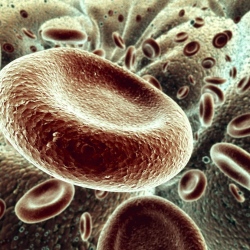
Georgia Institute of Technology researchers have used complex computational models to design swimming micro-robots that could carry cargo and navigate in response to stimuli such as light.
The micron-scale (about 1 millionth of a meter) devices could be used in drug delivery in the body, in lab-on-a-chip microfluidic systems, and even as micro-construction robots working in swarms.
The concept is similar to other micro-robots mentioned on KurzweilAI, but the Georgia Tech design focuses uniquely on hydrogels and computational fluid modeling.
When you’re just a few microns long, swimming can be difficult. At that size scale, the viscosity of water is more like that of honey, and momentum can’t be relied upon to maintain forward motion.
But with hydrogels, their volume changes in a cyclical way. So they would serve as “chemical engines” to provide the motion needed to move the device’s propulsive flaps. Such materials currently exist and are being improved upon for other applications.
“We believe that our simulations will give experimentalists a reason to pursue development of these micro-swimmers to go beyond what is available now,” said Alexander Alexeev, an assistant professor in the George W. Woodruff School of Mechanical Engineering at Georgia Tech. “We wanted to demonstrate the principle of how robots this small could move by determining what is important and what would need to be used to build a real system.”
Micron-scale design
The simple swimmer designed by Alexeev and collaborators Hassan Masoud and Benjamin Bingham consists of a responsive gel body about ten microns long with two propulsive flaps attached to opposite sides. A steering flap sensitive to specific stimuli would be located at the front of the swimmer.
The responsive gel body would undergo periodic expansions and contractions triggered by oscillatory chemical reactions, oscillating magnetic or electric fields, or by cycles of temperature change. These expansions and contractions — the chemical swelling and de-swelling of the material — would create a beating motion in the rigid propulsive flaps attached to each side of the micro-swimmer. Combined with the movement of the gel body, the beating motion would move the micro-swimmer forward.
The trajectory of the micro-swimmer would be controlled by a flexible steering flap on its front. The flap would be made of a material that deforms based on changes in light intensity, temperature or magnetic field.
“The combination of these flaps and the oscillating body creates a very nice motion that we believe can be used to propel the swimmer,” said Alexeev. “To build a device that is autonomous and self-propelling at the micron-scale, we cannot build a tiny submarine. We have to keep it simple.”
“We are using the state-of-the art in materials science, changing the properties of the material,” explained Masoud, a Ph.D. candidate in the School of Mechanical Engineering. “We have combined the materials with the principles of hydrodynamics at the small scale to develop this new swimmer.”
